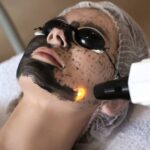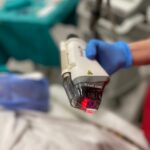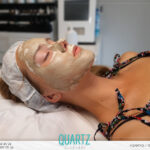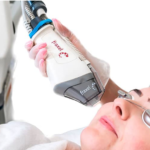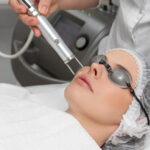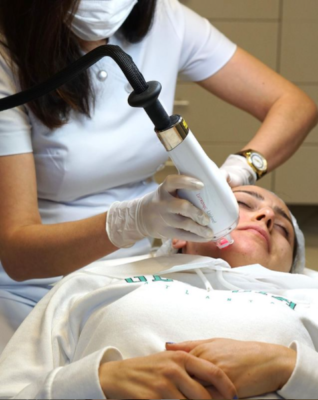 With laser skin resurfacing application, laser treatment for face lift, skin rejuvenation, treatment of wrinkles, treatment of acne scars, treatment of scars, treatment of spots, removal of lesions from the skin (moles, warts, etc.) are performed. The possible power of laser technology, which is developing today, is used to treat facial wrinkles, acne scars and other existing scars, blemishes on the skin.
With laser skin resurfacing application, laser treatment for face lift, skin rejuvenation, treatment of wrinkles, treatment of acne scars, treatment of scars, treatment of spots, removal of lesions from the skin (moles, warts, etc.) are performed. The possible power of laser technology, which is developing today, is used to treat facial wrinkles, acne scars and other existing scars, blemishes on the skin.
If you have a goal of improving your skin appearance and treating your minor imperfections, Laser Skin Resurfacing is for you!
What is Laser Skin Resurfacing?
Laser skin resurfacing is an aesthetic application that uses laser technology to reshape the surface of people’s skin. laser resurfacing face is performed to reduce skin imperfections, improve the appearance of the skin and rejuvenate the skin. Since laser skin resurfacing application is a special procedure and may require a healing process, it should be performed by a specialist doctor. laser skin resurfacing is performed by the following methods:
Ablative laser: This type of laser removes the thin outer layer of a person’s skin (epidermis) and heats the underlying skin (dermis) stimulating the growth of collagen, a protein that improves skin texture. After the epidermis heals and regrows, the treated area looks much smoother and tighter than before. Ablative laser treatment for face types include fractional laser, thulium laser, erbium laser and combination systems.
Non-ablative laser or light source: This approach also stimulates collagen growth. It is a less aggressive approach than ablative laser and has a shorter recovery time. But the results are less noticeable. Types include pulsed dye laser, erbium (Er:YAG) and intense pulsed light (IPL) treatment.
In every treatment method, fractional laser application can be made throughout the treatment area. This is because a fractional laser shortens the recovery time and reduces the risk of side effects. With laser skin resurfacing, the appearance of fine lines on the face of patients is reduced and with it, it treats skin tone loss. It should be noted that sagging skin cannot be removed by laser skin resurfacing .
Which cases is Laser Resurfacing applied?
laser skin resurfacing treatment is performed to improve the appearance and quality of the skin of patients. It is effective for solving the following problems:
- Wrinkles: Aging, sun damage or other factors can cause the skin to lose its elasticity and wrinkles can form. It helps to fix these problems.
- Spots: Pigmentation disorders, spots or spots prevent the skin from giving a smooth appearance.
- Skin thickness: Problems such as fine lines that impair the appearance of the skin or decrease in the thickness of the skin are eliminated.
- Scars: It removes scars caused by surgery, burns or other causes.
How is skin resurfacing treatment applied?
The doctor can perform laser skin resurfacing by performing an outpatient procedure on the patient. First of all, the patient’s skin is anesthetized with the drug. You can be sedated in our clinic for comprehensive skin rejuvenation procedures, such as applying to your entire face.
While skin resurfacing treatment is performed with ablative laser, an intense beam of light energy (laser) is directed to the patient’s skin. The laser beam destroys the outer layer of the skin (epidermis). And then the laser heats the underlying skin (dermis). In this way, collagen production is stimulated and better skin tone and texture are formed.
Ablative laser skin resurfacing can take approximately 30 minutes to 120 minutes, depending on the technique used by the doctor and the size of the treated area. With this application, only one treatment is done.
Non-ablative laser treatment or laser resurfacing treatment with fractional Er:YAG laser can last for long weeks or months. To achieve effective results, the patient will likely need at least 3 treatments, 1 scheduled over weeks or months.
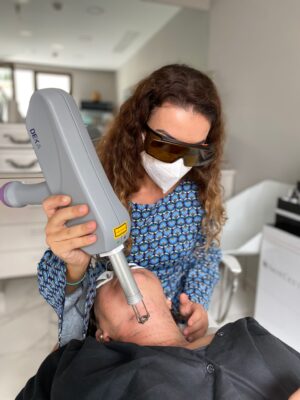 What are the risks of Laser Skin Resurfacing treatment?
What are the risks of Laser Skin Resurfacing treatment?
Laser skin resurfacing can cause various side effects in patients. If we compare these possible side effects to non-ablative laser skin resurfacing, they are milder and less frequent in approaches than non-ablative treatment.
- Pain, swelling, redness: These side effects are the most common side effects of laser skin resurfacing and generally go away within a few days.
- Infection: It can occur if the treated area of the patient’s skin is contaminated.
- Scar: There is a risk of scar with any laser skin resurfacing treatment, but this is more likely with more aggressive treatments.
- Changes in skin color: The treated skin may be lighter or darker than the surrounding skin. This situation is delayed.
- Eye injury: If the laser used in resurfacing is not properly protected, it can damage the patient’s eyes. It is very important that it is done by a doctor who is an expert in her/his field.
- Nerve damage: In rare cases, laser skin resurfacing can cause nerve damage that can result in numbness, tingling, or other sensations.
- Poor healing: Treated skin may not heal properly, leaving a visible scar or other blemish.
What should be considered after laser resurfacing treatment?
After laser skin resurfacing, it is very important to follow the doctor’s post-procedure instructions carefully in order to minimize the risk of complications in patients or to ensure proper healing. The following are the situations that need attention:
- It is necessary to protect the treated area from sunlight. This is very important to prevent further damage to the patient’s skin and to reduce the risk of scarring.
- It is necessary to keep the treated area clean and moist. It helps prevent possible infection and promote healing.
- It is very important to avoid messing or scratching the treated area. This causes further damage to the skin and increases the risk of scarring.
- Aggressive skin care products should be avoided. This includes exfoliants, harsh chemicals and other products that can irritate the skin.
- You have to be careful while shaving. If you have a beard, you should be gentle when shaving and avoid using a razor on the treated area until it is completely healed.
- It is important not to use cigarettes and alcohol. Such substances can impair the healing process and increase the risk of complications.
- Unusual symptoms should be reported to the doctor. This is any change in skin color or sensation, along with signs of infection such as redness, swelling, and pain.
How much does laser skin resurfacing cost in Istanbul, Turkey?
The skin resurfacing cost (fractional laser resurfacing) can vary greatly depending on several factors, such as the type of laser used in the treatment, the size of the treatment area, and the experience of the doctor and the location of the clinic. Considering the skin resurfacing cost, it should not be forgotten that the treatment is applied to obtain long-term results.
Choosing a licensed, qualified and experienced doctor and clinic is very important in order to minimize the risk of complications, which is the most important thing in laser skin resurfacing, and to apply the laser treatment for face in order to obtain the best possible result. It is not legal to specify prices on websites for centers accredited by the Ministry of Health. For this reason, you can contact Quartz Clinique by calling 0212 241 46 24 and get information about laser face treatment price.

